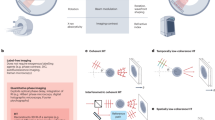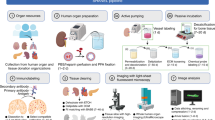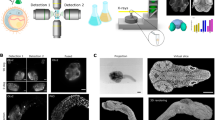High-resolution 3D imaging of fixed and cleared organoids (original) (raw)
- Protocol
- Published: 03 May 2019
- Maria Alieva1,3,4 na1,
- Lianne M. Wellens1,3,4 na1,
- Hendrikus C. R. Ariese1,3,4,
- Paul R. Jamieson5,
- Annelotte M. Vonk6,7,
- Gimano D. Amatngalim6,7,
- Huili Hu2,3,4,
- Koen C. Oost3,8,
- Hugo J. G. Snippert3,8,
- Jeffrey M. Beekman6,7,
- Ellen J. Wehrens1,3,4,
- Jane E. Visvader5,9 na2,
- Hans Clevers ORCID: orcid.org/0000-0002-3077-55821,2,3,4 na2 &
- …
- Anne C. Rios ORCID: orcid.org/0000-0002-9082-80681,3,4 na2
Nature Protocols volume 14, pages 1756–1771 (2019)Cite this article
- 58k Accesses
- 305 Citations
- 59 Altmetric
- Metrics details
Subjects
Abstract
In vitro 3D organoid systems have revolutionized the modeling of organ development and diseases in a dish. Fluorescence microscopy has contributed to the characterization of the cellular composition of organoids and demonstrated organoids’ phenotypic resemblance to their original tissues. Here, we provide a detailed protocol for performing high-resolution 3D imaging of entire organoids harboring fluorescence reporters and upon immunolabeling. This method is applicable to a wide range of organoids of differing origins and of various sizes and shapes. We have successfully used it on human airway, colon, kidney, liver and breast tumor organoids, as well as on mouse mammary gland organoids. It includes a simple clearing method utilizing a homemade fructose–glycerol clearing agent that captures 3D organoids in full and enables marker quantification on a cell-by-cell basis. Sample preparation has been optimized for 3D imaging by confocal, super-resolution confocal, multiphoton and light-sheet microscopy. From organoid harvest to image analysis, the protocol takes 3 d.
This is a preview of subscription content, access via your institution
Access options
Access Nature and 54 other Nature Portfolio journals
Get Nature+, our best-value online-access subscription
$29.99 / 30 days
cancel any time
Subscribe to this journal
Receive 12 print issues and online access
$259.00 per year
only $21.58 per issue
Buy this article
- Purchase on SpringerLink
- Instant access to full article PDF
Prices may be subject to local taxes which are calculated during checkout
Additional access options:
Similar content being viewed by others

Holotomography
Article 25 July 2024


Data availability
All data generated or analyzed during this study are included in this published article (and its supplementary information files).
References
- Sato, T. & Clevers, H. SnapShot: growing organoids from stem cells. Cell 161, 1700–1700.e1 (2015).
Article CAS Google Scholar - Clevers, H. Modeling development and disease with organoids. Cell 165, 1586–1597 (2016).
Article CAS Google Scholar - Drost, J. & Clevers, H. Organoids in cancer research. Nat. Rev. Cancer 18, 407–418 (2018).
Article CAS Google Scholar - Bartfeld, S. & Clevers, H. Stem cell-derived organoids and their application for medical research and patient treatment. J. Mol. Med. 95, 729–738 (2017).
Article CAS Google Scholar - Broutier, L. et al. Human primary liver cancer-derived organoid cultures for disease modeling and drug screening. Nat. Med. 23, 1424–1435 (2017).
Article CAS Google Scholar - Dekkers, J. F. et al. Characterizing responses to CFTR-modulating drugs using rectal organoids derived from subjects with cystic fibrosis. Sci. Transl. Med. 8, 344ra384 (2016).
Article Google Scholar - Dekkers, J. F. et al. A functional CFTR assay using primary cystic fibrosis intestinal organoids. Nat. Med. 19, 939–945 (2013).
Article CAS Google Scholar - Sato, T. et al. Single Lgr5 stem cells build crypt-villus structures in vitro without a mesenchymal niche. Nature 459, 262–265 (2009).
Article CAS Google Scholar - Karthaus, W. R. et al. Identification of multipotent luminal progenitor cells in human prostate organoid cultures. Cell 159, 163–175 (2014).
Article CAS Google Scholar - Lancaster, M. A. et al. Cerebral organoids model human brain development and microcephaly. Nature 501, 373–379 (2013).
Article CAS Google Scholar - Hu, H. et al. Long-term expansion of functional mouse and human hepatocytes as 3D organoids. Cell 175, 1591–1606.e19 (2018).
Article CAS Google Scholar - Huch, M. et al. Long-term culture of genome-stable bipotent stem cells from adult human liver. Cell 160, 299–312 (2015).
Article CAS Google Scholar - Nanki, K. et al. Divergent routes toward Wnt and R-spondin niche independency during human gastric carcinogenesis. Cell 174, 856–869.e17 (2018).
Article CAS Google Scholar - Jamieson, P. R. et al. Derivation of a robust mouse mammary organoid system for studying tissue dynamics. Development 144, 1065–1071 (2017).
Article CAS Google Scholar - Sachs, N. et al. A living biobank of breast cancer organoids captures disease heterogeneity. Cell 172, 373–386.e10 (2018).
Article CAS Google Scholar - Turco, M. Y. et al. Long-term, hormone-responsive organoid cultures of human endometrium in a chemically defined medium. Nat. Cell Biol. 19, 568–577 (2017).
Article CAS Google Scholar - Maimets, M. et al. Long-term in vitro expansion of salivary gland stem cells driven by Wnt signals. Stem Cell Rep. 6, 150–162 (2016).
Article CAS Google Scholar - Ren, W. et al. Single Lgr5- or Lgr6-expressing taste stem/progenitor cells generate taste bud cells ex vivo. Proc. Natl. Acad. Sci. USA 111, 16401–16406 (2014).
Article CAS Google Scholar - Richardson, D. S. & Lichtman, J. W. Clarifying tissue clearing. Cell 162, 246–257 (2015).
Article CAS Google Scholar - Richardson, D. S. & Lichtman, J. W. SnapShot: tissue clearing. Cell 171, 496–496.e1 (2017).
Article CAS Google Scholar - Rios, A. C. et al. Essential role for a novel population of binucleated mammary epithelial cells in lactation. Nat. Commun. 7, 11400 (2016).
Article CAS Google Scholar - Rios, A. C., Fu, N. Y., Lindeman, G. J. & Visvader, J. E. In situ identification of bipotent stem cells in the mammary gland. Nature 506, 322–327 (2014).
Article CAS Google Scholar - Rios, A. C. & Clevers, H. Imaging organoids: a bright future ahead. Nat. Methods 15, 24–26 (2018).
Article CAS Google Scholar - Sachs, N. et al. Long‐term expanding human airway organoids for disease modeling. EMBO J. 38, e100300 (2019).
Article Google Scholar - Shutgens, F. et al. Tubuloids derived from human adult kidney and urine for personalized disease modelling. Nat. Biotechnol. 37, 303–313 (2019).
Article Google Scholar - Eisenstein, M. Transparent tissues bring cells into focus for microscopy. Nature 564, 147–149 (2018).
Article CAS Google Scholar - Erturk, A. et al. Three-dimensional imaging of solvent-cleared organs using 3DISCO. Nat. Protoc. 7, 1983–1995 (2012).
Article CAS Google Scholar - Renier, N. et al. iDISCO: a simple, rapid method to immunolabel large tissue samples for volume imaging. Cell 159, 896–910 (2014).
Article CAS Google Scholar - Kubota, S. I. et al. Whole-body profiling of cancer metastasis with single-cell resolution. Cell Rep. 20, 236–250 (2017).
Article CAS Google Scholar - Murakami, T. C. et al. A three-dimensional single-cell-resolution whole-brain atlas using CUBIC-X expansion microscopy and tissue clearing. Nat. Neurosci. 21, 625–637 (2018).
Article CAS Google Scholar - Susaki, E. A. et al. Whole-brain imaging with single-cell resolution using chemical cocktails and computational analysis. Cell 157, 726–739 (2014).
Article CAS Google Scholar - Chung, K. et al. Structural and molecular interrogation of intact biological systems. Nature 497, 332–337 (2013).
Article CAS Google Scholar - Tomer, R., Ye, L., Hsueh, B. & Deisseroth, K. Advanced CLARITY for rapid and high-resolution imaging of intact tissues. Nat. Protoc. 9, 1682–1697 (2014).
Article CAS Google Scholar - Snippert, H. J. et al. Intestinal crypt homeostasis results from neutral competition between symmetrically dividing Lgr5 stem cells. Cell 143, 134–144 (2010).
Article CAS Google Scholar - Stelzer, E. H. Light-sheet fluorescence microscopy for quantitative biology. Nat. Methods 12, 23–26 (2015).
Article CAS Google Scholar - Huisken, J., Swoger, J., Del Bene, F., Wittbrodt, J. & Stelzer, E. H. Optical sectioning deep inside live embryos by selective plane illumination microscopy. Science 305, 1007–1009 (2004).
Article CAS Google Scholar
Acknowledgements
We are very grateful for the technical support from the Princess Máxima Center for Pediatric Oncology and to the Hubrecht Institute and Zeiss for imaging support and collaborations. All the imaging was performed at the Princess Máxima imaging center. This work was financially supported by the Princess Máxima Center for Pediatric Oncology. J.F.D. was supported by a Marie Curie Global Fellowship and a VENI grant from the Netherlands Organisation for Scientific Research (NWO). J.E.V. was supported by the Australian National Health and Medical Research Council (NHMRC).
Author information
Author notes
- These authors contributed equally: Maria Alieva, Lianne M. Wellens.
- These authors jointly supervised this work: Jane E. Visvader, Hans Clevers, Anne C. Rios.
Authors and Affiliations
- Princess Máxima Center for Pediatric Oncology, Utrecht, the Netherlands
Johanna F. Dekkers, Maria Alieva, Lianne M. Wellens, Hendrikus C. R. Ariese, Ellen J. Wehrens, Hans Clevers & Anne C. Rios - Hubrecht Institute, Royal Netherlands Academy of Arts and Sciences (KNAW) and University Medical Center (UMC) Utrecht, Utrecht, the Netherlands
Johanna F. Dekkers, Huili Hu & Hans Clevers - Department of Cancer Research, Oncode Institute, Hubrecht Institute–KNAW Utrecht, Utrecht, the Netherlands
Johanna F. Dekkers, Maria Alieva, Lianne M. Wellens, Hendrikus C. R. Ariese, Huili Hu, Koen C. Oost, Hugo J. G. Snippert, Ellen J. Wehrens, Hans Clevers & Anne C. Rios - Cancer Genomics Center (CGC), Utrecht, the Netherlands
Johanna F. Dekkers, Maria Alieva, Lianne M. Wellens, Hendrikus C. R. Ariese, Huili Hu, Ellen J. Wehrens, Hans Clevers & Anne C. Rios - Stem Cells and Cancer Division, The Walter and Eliza Hall Institute of Medical Research, Parkville, VIC, Australia
Paul R. Jamieson & Jane E. Visvader - Regenerative Medicine Center Utrecht, University Medical Center, Utrecht University, Utrecht, the Netherlands
Annelotte M. Vonk, Gimano D. Amatngalim & Jeffrey M. Beekman - Department of Pediatric Pulmonology, Wilhelmina Children’s Hospital, University Medical Center, Utrecht University, Utrecht, the Netherlands
Annelotte M. Vonk, Gimano D. Amatngalim & Jeffrey M. Beekman - Molecular Cancer Research, Center for Molecular Medicine, University Medical Center Utrecht, Utrecht University, Utrecht, the Netherlands
Koen C. Oost & Hugo J. G. Snippert - Department of Medical Biology, The University of Melbourne, Parkville, VIC, Australia
Jane E. Visvader
Authors
- Johanna F. Dekkers
You can also search for this author inPubMed Google Scholar - Maria Alieva
You can also search for this author inPubMed Google Scholar - Lianne M. Wellens
You can also search for this author inPubMed Google Scholar - Hendrikus C. R. Ariese
You can also search for this author inPubMed Google Scholar - Paul R. Jamieson
You can also search for this author inPubMed Google Scholar - Annelotte M. Vonk
You can also search for this author inPubMed Google Scholar - Gimano D. Amatngalim
You can also search for this author inPubMed Google Scholar - Huili Hu
You can also search for this author inPubMed Google Scholar - Koen C. Oost
You can also search for this author inPubMed Google Scholar - Hugo J. G. Snippert
You can also search for this author inPubMed Google Scholar - Jeffrey M. Beekman
You can also search for this author inPubMed Google Scholar - Ellen J. Wehrens
You can also search for this author inPubMed Google Scholar - Jane E. Visvader
You can also search for this author inPubMed Google Scholar - Hans Clevers
You can also search for this author inPubMed Google Scholar - Anne C. Rios
You can also search for this author inPubMed Google Scholar
Contributions
J.F.D. designed the study, performed experiments and interpreted data; J.F.D., M.A., L.M.W., H.C.R.A. and P.R.J. performed experiments and analyzed data; J.F.D., P.R.J., A.M.V., G.D.A., H.H. and J.M.B. performed the organoid culturing. K.C.O. and H.J.G.S. provided fluorescent constructs; A.C.R. helped design the study and carried out data interpretation; J.F.D. and A.C.R. cowrote the manuscript. J.E.V., H.C. and E.J.W. helped with data interpretation, manuscript writing and corrections.
Corresponding author
Correspondence toAnne C. Rios.
Ethics declarations
Competing interests
H.C. is named as inventor on several patents related to organoid technology. J.F.D. is named as inventor on one patent related to the organoid technology.
Additional information
Journal peer review information: Nature Protocols thanks Xavier Gidrol, Melissa Skala and other anonymous reviewer(s) for their contribution to the peer review of this work.
Publisher’s note: Springer Nature remains neutral with regard to jurisdictional claims in published maps and institutional affiliations.
Related links
Key references using this protocol
Hu, H. et al. Cell 175, 1591–1606.e19 (2018): https://doi.org/10.1016/j.cell.2018.11.013
Sachs, N. et al. EMBO J. 38, e100300 (2019): https://doi.org/10.15252/embj.2018100300
Supplementary information
Supplementary Video 1
This video highlights the intricate 3D features of delicate organoid structures that can be imaged at cellular or even subcellular resolution with this sample-preparation protocol.
Reporting Summary
Rights and permissions
About this article
Cite this article
Dekkers, J.F., Alieva, M., Wellens, L.M. et al. High-resolution 3D imaging of fixed and cleared organoids.Nat Protoc 14, 1756–1771 (2019). https://doi.org/10.1038/s41596-019-0160-8
- Received: 13 December 2018
- Accepted: 04 March 2019
- Published: 03 May 2019
- Issue Date: June 2019
- DOI: https://doi.org/10.1038/s41596-019-0160-8